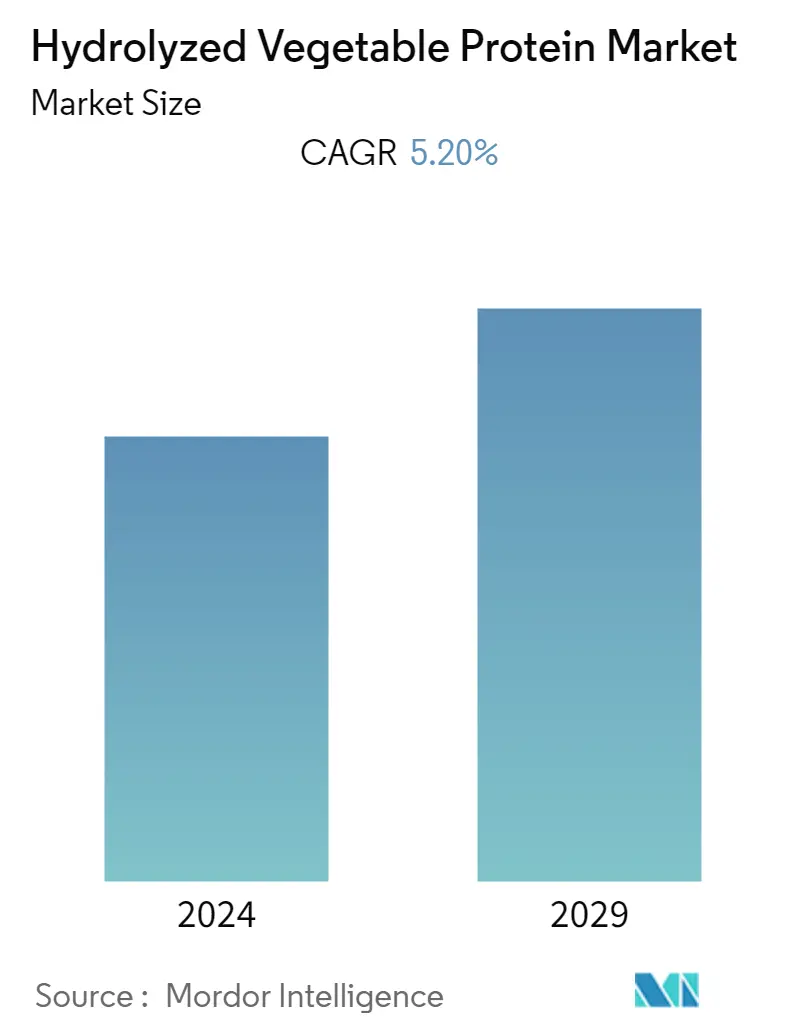Market Size of Hydrolyzed Vegetable Protein Industry

| Study Period | 2019 - 2029 |
| Base Year For Estimation | 2023 |
| Forecast Data Period | 2024 - 2029 |
| CAGR | 5.20 % |
| Fastest Growing Market | Europe |
| Largest Market | North America |
| Market Concentration | Low |
Major Players
*Disclaimer: Major Players sorted in no particular order |
Hydrolyzed Vegetable Protein Market Analysis
The global hydrolyzed vegetable protein market is growing at a CAGR of 5.2% during the forecast period (2020-2025).
- The market is driven by the increasing demand for a protein-based diet which is supported by protein-rich natural ingredients and clean-labeled food products among health-conscious consumers. Also, rising demand for hydrolyzed vegetable protein has high demand as a flavor enhancer in sauces, soups, snacks, and ready-to-eat food products are further boosting the market growth. Geographically, the United States in North America and China in the Asia Pacific accounts for the largest share in the global protein hydrolysate market, and Europe and South Americais expected to register the fastest growth.
- However, the major limitation for the market is the stringent regulations set by the regulatory bodies such as the European Union and FDA, which has affected the importers of hydrolyzed vegetable protein most adversely.
Hydrolyzed Vegetable Protein Industry Segmentation
The global hydrolyzed vegetable protein market is segmented by form into a dry powder, liquid, and paste; by application into food and beverage, personal care products and others. Food and beverage can be further bifurcated into the bakery, snack foods, soups, sauces & dressings, meat & meat products, beverages, and others. Also, the study provides an analysis of the hydrolyzed vegetable protein market in the emerging and established markets across the globe, including North America, Europe, Asia-Pacific, South America, and Middle East & Africa.
| By Form | |
| By Application | |
| Personal Care Products | |
| Others |
| Geography | |||||||||
| |||||||||
| |||||||||
| |||||||||
|
Hydrolyzed Vegetable Protein Market Size Summary
The hydrolyzed vegetable protein market is experiencing significant growth, driven by the increasing consumer demand for protein-rich diets and clean-labeled food products. This trend is particularly evident among health-conscious individuals who prefer natural ingredients. The market is further bolstered by the rising use of hydrolyzed vegetable protein as a flavor enhancer in various food products such as sauces, soups, snacks, and ready-to-eat meals. Geographically, North America, led by the United States, and Asia Pacific, with China, hold the largest market shares, while Europe and South America are anticipated to witness the fastest growth. However, the market faces challenges due to stringent regulations from bodies like the European Union and FDA, which impact importers adversely.
The shift towards vegan diets and the incorporation of plant proteins in processed foods are key factors propelling the market forward. Consumer preferences are increasingly leaning towards plant proteins due to the allergies associated with animal proteins and the nutritional benefits of plant-based alternatives. This shift is supported by scientific advancements and a growing awareness of the environmental advantages of plant proteins over animal sources. The European market, in particular, is experiencing rapid growth due to changing consumption patterns and rising veganism, with companies innovating to produce plant-based products that mimic the taste and texture of meat. The competitive landscape of the hydrolyzed vegetable protein market is marked by numerous domestic and multinational players, with companies like Ajinomoto Co., Inc., Tate & Lyle PLC, Griffith Foods Inc., and Dien, Incorporated leading the charge through strategic product launches and partnerships.
Hydrolyzed Vegetable Protein Market Size - Table of Contents
-
1. MARKET DYNAMICS
-
2. MARKET SEGMENTATION
Hydrolyzed Vegetable Protein Market Size FAQs
What is the current Hydrolyzed Vegetable Protein Market size?
The Hydrolyzed Vegetable Protein Market is projected to register a CAGR of 5.2% during the forecast period (2025-2030)
Who are the key players in Hydrolyzed Vegetable Protein Market?
Ajinomoto Co,. Inc., Tate & Lyle PLC, Griffith Foods Inc., Dien, Incorporated and Titan Biotech Limited are the major companies operating in the Hydrolyzed Vegetable Protein Market.

